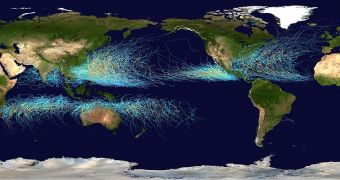Global warming is believed to be a serious contributor to the frequency and intensity of hurricanes in the Northern Atlantic at this point, but pieces of evidence of this are not widely agreed upon. As a result, looking back into the planet's hurricane history could make it clear if the recent spike in the weather events is nothing but a random occurrence, or if it's unnatural. Seismologists have recently come up with a way of tracking the phenomenon back in the past, by looking at the seismic noise our planet makes. The rich trove of seismic records should provide climatologists with everything they need.
“Looking for something like hurricane records in seismology doesn't occur to anybody. It's a strange and wondrous combination,” Northwestern University (NU) scientist Carl Ebeling reveals, quoted by AlphaGalileo. The question of whether warming sea water on the surface of the Atlantic Ocean is to blame for the recent devastating storms in Northern America is a very tough one to answer, he adds.
In order for a trend to be determined, scientists need to have all the data. However, before satellite observations began, in the 1960s, there were very little means of keeping tabs on the weather. Monitoring was mostly done via ships, planes, and ground-based weather stations, which might have very well missed some hurricanes. These events may have lasted for a week or less, but they may not show up in researchers' numbers, which means that any attempt of creating a historic model is bound to be surrounded by doubt.
Seismic noises are extremely suited for such studies, Ebeling and colleague Seth Stein say. The ever-present background signal that bathes the surface of the Earth is fueled, energy-wise, from the atmosphere, and then transmitted through the oceans into the planet's crust. Through the rocks, it propagates as waves, which researchers noticed to have slight variations in frequency. Until now, this has been largely ignored, and the only changes that were taken into account were large ones, which were produced by earthquakes.
The team believes that hurricanes produce subtle variations in the seismic waves. “There's definitely something there that shows this can be workable. This is something new and interesting,” Ebeling says. Now, all that remains to be done is for the team to find a good method of digitizing more than a century of seismic data. Thousands of hours of data have been collected on paper, as it was customary in the 20th century, and working with miles of sheets is scientifically impractical.

 14 DAY TRIAL //
14 DAY TRIAL //